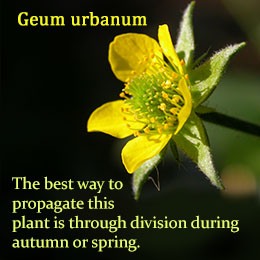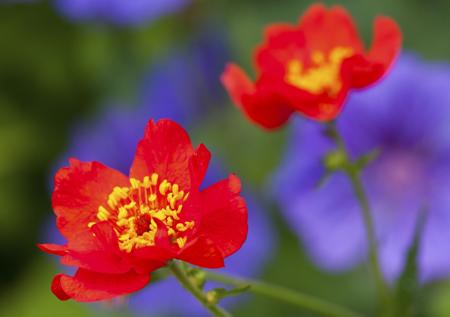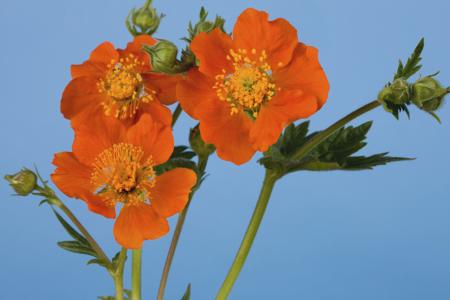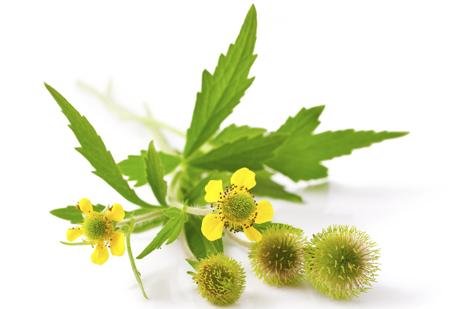Geum refers to a genus of around 50 species of perennial herbaceous plants. Buzzle provides tips on growing and caring for geum plants.

The Royal Horticultural Society granted the Award of Garden Merit (AGM) to
Geum 'Mrs. J Bradshaw', a tough and hardy geum species that produces rich green foliage and bright red flowers.Most gardening enthusiasts are often on a lookout for plants that not only look beautiful, but are easy to care for. Flowering plants often figure on the top of their list. Those who are eager to grow such plants in their garden should opt for perennial flowering plants that will live for three or more seasons. Unlike annuals that bloom all season long but live for just one season, perennials produce flowers and seeds from the same root year after year. Thus, the best way to keep your garden looking colorful at all times would be to pair them with other perennials that produce flowers at other times.
Geum, which is a genus of around 50 species of rhizomatous herbaceous plants that belongs to the Rosaceae family, is a perennial that would be a welcome addition to any flower garden due to its beautiful foliage and flowers.Geum Plant CareIt must be noted that geums will do well across USDA Hardiness Zones 4 to 9. Though these plants are easy to care for, there can be issues if the growing conditions are not suitable. Look out for signs of damage. Geums can get affected by spider mites, leaf spots, mildew, root rot, etc. So, if you are really keen on growing this plant, do provide it with the ideal conditions it needs for proper growth. Here's what you need to doPropagationThe propagation of plants, which means making new plants from the existing ones, is divided into two types. While sexual propagation involves growing a plant from seeds, asexual propagation involves the use of roots, stems, buds, and leaves. Asexual propagation can be achieved through dividing, cuttings, layering, budding, and grafting. To be able to get beautiful geum flowers, one has the option of propagating them through the method of division. This method of propagation is possible, as geum has more than one stem. All you need to do is dig up the established plant, and separate it into pieces. Ensure that each of these separate pieces has a root. Plant the pieces during spring or autumn. These can grow into full-sized plants that you can put in your garden. You can divide geum plants every 2 or 3 years. It is possible to grow geum by sowing the seeds outdoors in spring or summer, or sowing them indoors in late winter to early spring. However, division is a better and more reliable method.SoilGeums grow well in moist soil that is enriched with compost. They also require good drainage. The pH of the soil should lie between 5.5 and 7. Average, well-drained soil will work well; avoid wet soil in winter. During winter, attention must be paid to watering. The soil should not be waterlogged.WateringThe plant requires moisture on a regular basis. Make sure that the soil doesn't become too dry. It needs proper watering right after planting, especially during the first week. Thereafter, water it thoroughly once a week in summer. In the absence of rain, water the plants on a regular basis. Excessive watering can cause the soil to become soggy, which can cause root rot and adversely affect the plant. So, don't go on a watering spree during winter, as that can damage the plant.SunThis plant will thrive in regions with full sun. Full sun will promote flowering. However, it will also grow well if it is kept in an area where it gets morning sun and afternoon shade. For regions with hot and humid climate, it would be best to provide afternoon shade.FertilizersThere is no need to use a fertilizer at planting time and during the first growing season. Don't go overboard with fertilizers. In case of plants that are established, apply a balanced fertilizer lightly in early spring. Make sure that you follow the guidelines on the usage of the fertilizer given by the manufacturer on the label.Blooming SeasonThe flowering season for geum plants is between May and September. The flowers come in shades of orange, red, or yellow, depending on the species or the variety. These flowers can be used as cut flowers. In order to prolong the flowering season, the stems of the spent flowers can be cut off at the base. You can also opt for some of the hybrid varieties that produce five times the blooms in a single season than the older varieties.CultivarsSpecies from this genus produce flowers in vibrant shades of red, orange, and yellow.



Hybrids between
G. chiloense (from Chile) and
G. coccineum (from the Balkans) are quite popular. Here are some cultivars that produce beautiful flowers.
✦ Fire Opal (produces red semi-double flowers)
✦ Lady Stratheden (produces yellow double flowers)
✦ Mrs. J. Bradshaw (produces large reddish-orange. double flowers)
✦ Dolly North (produces orange flowers)
✦ Red Wings (produces red semi-double flowers)
✦ Red Dragon (produces double scarlet-red to orange flowers)
✦ Fire Storm (produces rounded golden yellow semi-double flowers with reddish-orange color towards the edge of the petals)
✦ Flames of Passion (produces small, rounded semi-double scarlet flowers)
✦ Blazing Sunset (produces double tangerine-red blooms)
✦ Georgenberg (produces saucer-shaped, bright-golden orange single blooms)
✦ Double Bloody Mary (produces double flowers of blood-red hue)
✦ Mai Tai (produces gold/light pink/orange semi-double to single flowers)
✦ Album (produces white to pale pink flowers)
✦ Prairie Smoke (produces rose-colored seed head)
✦ Mango lassi (produces apricot and buttery yellow double flowers)
✦ Totally tangerine (produces golden/orange blooms)
✦ Eos (produces bright orange blooms and chartreuse/yellow foliage)
Some of the popular species and cultivars include:
✦
Geum triflorum 'Prairie Smoke'
✦
Geum chiloense (cultivars 'Mrs. Bradshaw, Lady Stratheden, and Dolly North)
✦
Geum rivale 'Album'
✦
Geum heldreichii 'Georgenberg'
✦
Geum avens 'Double Bloody Mary'
Popular species for wildflower garden include:
✦
Geum aleppicum (produces yellow flowers and is native to temperate Northern hemisphere)
✦
Geum macrophyllum (produces yellow flowers and is native to North America)
✦
Geum canadense (produces white flowers and is native to North America)
✦
Geum urbanum (produces yellow flowers and is native to Europe)On a concluding note, geum flowers can certainly add color to your flower garden. With slender, wiry, flowering stems and green foliage, they are an opt choice for border plantings. These can also be grown in containers. You can also make them a part of a rock garden. All you need to do is provide them all the conditions that they need to grow. To add to that, the blooms attract butterflies such as the Grizzled Skipper.






 The Royal Horticultural Society granted the Award of Garden Merit (AGM) to Geum 'Mrs. J Bradshaw', a tough and hardy geum species that produces rich green foliage and bright red flowers.Most gardening enthusiasts are often on a lookout for plants that not only look beautiful, but are easy to care for. Flowering plants often figure on the top of their list. Those who are eager to grow such plants in their garden should opt for perennial flowering plants that will live for three or more seasons. Unlike annuals that bloom all season long but live for just one season, perennials produce flowers and seeds from the same root year after year. Thus, the best way to keep your garden looking colorful at all times would be to pair them with other perennials that produce flowers at other times.
The Royal Horticultural Society granted the Award of Garden Merit (AGM) to Geum 'Mrs. J Bradshaw', a tough and hardy geum species that produces rich green foliage and bright red flowers.Most gardening enthusiasts are often on a lookout for plants that not only look beautiful, but are easy to care for. Flowering plants often figure on the top of their list. Those who are eager to grow such plants in their garden should opt for perennial flowering plants that will live for three or more seasons. Unlike annuals that bloom all season long but live for just one season, perennials produce flowers and seeds from the same root year after year. Thus, the best way to keep your garden looking colorful at all times would be to pair them with other perennials that produce flowers at other times.

 Hybrids between G. chiloense (from Chile) and G. coccineum (from the Balkans) are quite popular. Here are some cultivars that produce beautiful flowers.
Hybrids between G. chiloense (from Chile) and G. coccineum (from the Balkans) are quite popular. Here are some cultivars that produce beautiful flowers.